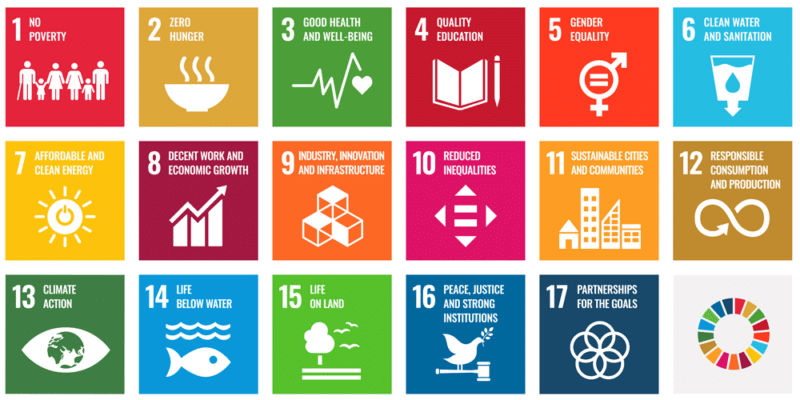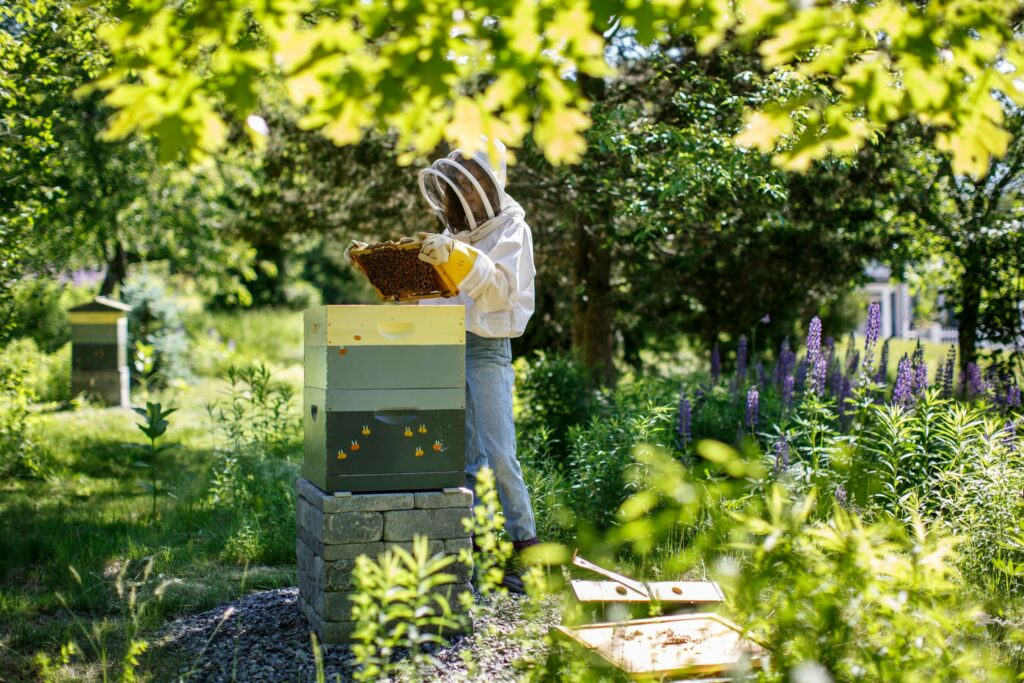Contents:
- A Best Bees Guide to SDGs, ESGs, and Biodiversity
- What is ESG Investing, and How Does It Support SDGs?
- ESG Factors
- Connecting ESG and Biodiversity
- Including Beehives in your Corporate Sustainability Plan
- Corporate ESG and Biodiversity Examples
- FAQs
A Best Bees Guide to SDGs, ESGs, and Biodiversity
At this point in our global economy, it is expected that large companies and their stakeholders invest properly and proudly towards a more sustainable future. It is the inherent responsibility of large organizations to affect positive change both locally and globally, all while adapting to new practices of doing so. The United Nations’ Sustainable Development Goals, or SDGs, are recognized as a beneficial foundation for sustainability efforts. SDGs offer a realistic framework for Environmental, Social, and Governance practices (ESGs). ESGs, and the analysis of them, have become crucial in helping businesses invest in more sustainable practices.
~The TNFD is the first sustainability reporting framework specifically designed for biodiversity and nature-related issues. Download our white paper to learn how it’s prompting businesses to take decisive action~
Thankfully, leaders of today are seeking to adopt more comprehensive plans for their company’s sustainability and societal impacts – often referring to the ESG targets for guidance on how to support the UN’s SDGs. Now, more than ever, it’s important to educate one another on the ways to support corporate sustainability targets, align with global goals, and make an impact on our environment. One incredibly effective way to do this is by promoting biodiversity, which is simply defined as all the variety of life that can be found on Earth, from plants, to animals, fungi, and micro-organisms. More so, it means that everything is connected and depends on one another to survive!
Investing in biodiversity is one of many ways that businesses and citizens can ensure that our ecosystem and agriculture thrive. Today, we’ll dive a bit more into SDGs, ESGs, why we should care about investing in them, and how biodiversity is one of the largest driving factors of combating climate change for a better, greener future.
What is ESG Investing, and How Does It Support SDGs?

The value of investing is no longer just about returns – it’s about the global impact of the world at large. The UN’s SDGs were adopted by the UN as a universal call to action to end poverty, protect the planet, and ensure that future generations can enjoy peace and prosperity. This vision serves as the overarching goal, and investors and businesses can utilize this to assess the impact of ESG investment strategies and set ESG goals. The UN created 17 SDGs, allowing for targeted efforts and achievable checkpoints.
As large companies continue to grow, ESG analysis has become a non-negotiable in an investment strategy. Investors want, and demand, that their money goes towards stocks or funds that are both profitable and reflective of their social values. Not to mention, customers of today care deeply about the motives of businesses that they buy from and understand that their dollar is in support of any initiative the organization funds.
You’ll see investors incorporating valuable data into the investment process to gain a better understanding of what companies they are willing to invest in. There are two main types of investing styles to fulfill this demand: environmental, social, and governance (ESG) and socially responsible investing (SRI). ESG looks at the company’s environmental, social, and governance practices, alongside more traditional financial measures, while socially responsible investing (SRI) involves actively removing or choosing investments based on specific ethical guidelines.
ESG Factors
When accounting for what constitutes an ESG, there is no one-size-fits-all list of examples. While ESG factors can be challenging to classify, they are briefly outlined as the following:
Environmental: Conservation of the natural world
- Biodiversity
- Climate change and carbon emissions
- Air, land, and water pollution
- Deforestation
- Energy efficiency
- Waste management
- Water scarcity
Social: Consideration of people and relationships
- Customer satisfaction
- Gender and diversity
- Data protection and privacy
- Employee engagement
- Community relations
- Human rights
- Labor standards
Governance: Standards for running a company
- Board composition
- Audit committee structure
- Bribery and corruption
- Executive compensation
- Lobbying
- Political contributions
- Whistleblower schemes
Connecting ESG and Biodiversity
It is paramount that we continue to educate our customers, advocates, and team members on the link between ESGs and the subsequent investment in biodiversity. Unfortunately, we are living in a period of biodiversity decline, with concerns over pollinator deterioration, phenological changes, and the repercussions for food security. As a result, the past few decades have made bee populations decline steadily. While researchers and organizations like our team at the Best Bees Company have committed themselves to understanding the “why” behind this decline, we also know we must do all we can to remedy the loss of bees to our current global environment. Simply put, bees are the answer.
Bees are extremely important for our entire ecosystem to function, allowing over 80% of plants to reproduce through pollination. If the food sources for these pollinators were to disappear, it would cause an entire chain reaction of the food chain to suffer. Of the 17 SDGs, “Zero Hunger” is the second one on the list. If the pollination process declines or altogether disappears, we have the potential to lose plants, food for humans, animals, and even birds who depend on plants to survive.
Including Beehives in your Corporate Sustainability Plan
So, what’s the correlation between bees and top-tiered investors hoping to support organizations that include ESG in their business practices? It’s much more simple than you might think. Corporations can easily add data-yielding beehives to their sustainability initiatives and start making a global impact with just a few steps. With a networked beehive program, organizations can support a keystone species, advance pollinator health worldwide, and visibly demonstrate ethical priorities to stakeholders. The HoneyDNA samples that The Best Bees Company can extract from these beehives can even be incorporated into environmental reports, making a stronger case for ESG-forward investors. Not to mention, honey harvested from on-premise beehives makes for a unique amenity that offers local flavor, provides a deeper understanding of biodiversity, and sparks rich conversations about all kinds of environmental causes.
Adding data-yielding beehives to any sustainability portfolio is a simple solution that supports a grander ESG vision for forward-looking organizations. The ESG trend is clear, and organizations that wait to implement these practices may soon be playing catch-up with competitors. Compared to other ESG efforts, beehives are extremely simple to implement and manage, and that’s where we come in. At The Best Bees Company, we offer professional corporate beekeeping services that allow clients to make a true impact within their communities. Individual citizens, multinational corporations, and anyone in between can contribute to the health of honeybees and pollinators simply by creating a home for them.
Corporate ESG and Biodiversity Examples
When invested properly, a beekeeping service can provide invaluable data for the future of pollinators. With , the world’s first and largest beehive management system, our team tracks population, honey yields, queen health, diseases, and mite levels from over 10 years. Our clients, like real estate companies Beacon Capital and JLL, beauty world leader L’Oréal, and the Four Seasons all have made the commitment to a green future by hosting beehives on their rooftops in metropolitan cities. Our data, in partnership with our clients, have since been used in collaborations with NASA DEVELOP, Google Earth, MIT, and other partners to understand the plight of pollinators as a whole. Investing is not only important for businesses to thrive, but consumers want (and need) to know what corporations are doing to make our world a better place.
Every day we see new corporations investing in biodiversity and hive maintenance, and we are hopeful now, more than ever, about the future of bees and pollinators as a whole, and we can’t wait to see what lies ahead next season. Is your business interested in adding data-yielding beehives to your ESG program? Contact us to book an assessment.
In the meantime, learn more about the global impact that your corporation can make by hosting honeybees and download our recent white paper:
FAQs
Q: What does ESG stand for?
A: ESG stands for environmental, social, and governance
Q: What does SDG stand for?
A: Sustainable Development Goals
Q: What is ESG investing?
A: ESG investing is a form of investing style for companies, and includes valuable data that helps investors gain a better understanding of what companies they are willing to invest in, based on a variety of factors.
Q: What are the ESG factors?
A: While there is no one-size-fits-all list for what is considered an ESG factor, they can be briefly outlined as Environmental (conservation of the natural world), Social (consideration of people and relationships), and Governance (standards for running a company).
Q: What is biodiversity?
A: Biodiversity is defined as all the variety of life that can be found on Earth, including plants, animals, fungi, and microorganisms.
Q: How do beehives promote biodiversity?
A: By adding a network of data-yielding beehives to your sustainability portfolio, corporations can join a collective movement, fueled by science, to save the bees. Each beehive managed by The Best Bees Company is a data point that is actively bolstering research to improve pollinator health, promote biodiversity, and make a tangible impact on the environment.








